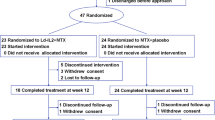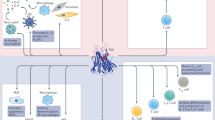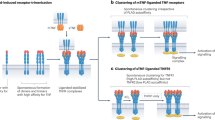Abstract
Cytokines such as tumor necrosis factor (TNF) are expressed at high levels in rheumatoid joint tissue, where they contribute significantly to inflammation and articular destruction. TNF was the first cytokine to be fully validated as a therapeutic target for rheumatoid arthritis (RA). In nearly a decade since anti-TNF agents—such as infliximab, etanercept and adalimumab—were launched as the first biologic therapies to be licensed for RA, much has been learnt about how and when in the disease course this class of drug can be used to achieve optimal therapeutic benefit. Other cytokine targets, such as interleukin (IL)-6 or IL-1, have also been validated and several are in the process of being tested. However, TNF is likely to remain the preferred target of first-line biologic therapy for the foreseeable future as, in populations with active RA despite ongoing, nonbiologic, DMARD therapy, biologic inhibition of either IL-6 or IL-1 demonstrates no obviously superior outcomes to TNF blockade. Furthermore, new approaches to blockade of signaling mediated by bioactive TNF might have the potential to generate higher-magnitude clinical responses than are currently elicited.
Key Points
-
Tumor necrosis factor (TNF) was the first cytokine to be fully validated as a therapeutic target for rheumatoid arthritis (RA)
-
Combination therapy with an anti-TNF biologic agent plus methotrexate halts progression of joint damage in the majority of patients with RA, irrespective of the extent of destruction on baseline radiography
-
Studies of patients with early RA receiving anti-TNF therapy show particularly favorable outcomes; high proportions of patients achieve sustained low disease activity or remission
-
One of the major pitfalls of biologic TNF inhibition is the occurrence of infectious complications (common or opportunistic)
-
Other shortcomings of current anti-TNF biologics include high costs, inadequate numbers of treated patients achieving sustained, high-magnitude responses or remission and secondary loss of efficacy over time
This is a preview of subscription content, access via your institution
Access options
Subscribe to this journal
Receive 12 print issues and online access
$209.00 per year
only $17.42 per issue
Buy this article
- Purchase on Springer Link
- Instant access to full article PDF
Prices may be subject to local taxes which are calculated during checkout

Similar content being viewed by others
References
Brennan, F. M., Chantry, D., Jackson, A., Maini, R. & Feldmann, M. Inhibitory effect of TNF-α antibodies on synovial cell interleukin-1 production in rheumatoid arthritis. Lancet 2, 244–247 (1989).
Butler, D. M., Maini, R. N., Feldmann, M. & Brennan, F. M. Modulation of proinflammatory cytokine release in rheumatoid synovial membrane cell cultures. Comparison of monoclonal anti-TNF-α antibody with the interleukin-1 receptor antagonist. Eur. Cytokine Netw. 6, 225–230 (1995).
Haworth, C. et al. Expression of granulocyte-macrophage colony-stimulating factor in rheumatoid arthritis: regulation by tumor necrosis factor-α. Eur. J. Immunol. 21, 2575–2579 (1991).
Williams, R. O., Feldmann, M. & Maini, R. N. Anti-tumor necrosis factor ameliorates joint disease in murine collagen-induced arthritis. Proc. Natl Acad. Sci. USA 89, 9784–9788 (1991).
Lipsky, P. E. et al. Infliximab and methotrexate in the treatment of rheumatoid arthritis. Anti-tumor necrosis factor trial in rheumatoid arthritis with concomitant therapy study group. N. Engl. J. Med. 343, 1594–1602 (2000).
Weinblatt, M. E. et al. A trial of etanercept, a recombinant tumor necrosis factor receptor–Fc fusion protein, in patients with rheumatoid arthritis receiving methotrexate. N. Engl. J. Med. 340, 253–259 (1999).
Weinblatt, M. E. et al. Adalimumab, a fully human anti-tumor necrosis factor α monoclonal antibody, for the treatment of rheumatoid arthritis in patients taking concomitant methotrexate: the ARMADA trial. Arthritis Rheum. 48, 35–45 (2003).
Keystone, E. et al. Certolizumab pegol plus methotrexate is significantly more effective than placebo plus methotrexate in active rheumatoid arthritis: findings of a fifty-two-week, phase III, multicenter, randomized, double-blind, placebo-controlled, parallel-group study. Arthritis Rheum. 58, 3319–3329 (2008).
Smolen, J. et al. Efficacy and safety of certolizumab pegol plus methotrexate in active rheumatoid arthritis: the RAPID 2 study. A randomised controlled trial. Ann. Rheum. Dis. 68, 797–804 (2009).
Keystone, E. C. et al. GO-FORWARD Study. Golimumab, a human antibody to tumour necrosis factor α given by monthly subcutaneous injections, in active rheumatoid arthritis despite methotrexate therapy: the GO-FORWARD study. Ann. Rheum. Dis. 68, 789–796 (2009).
Feldmann, M. & Maini, R. N. Lasker Clinical Medical Research Award. TNF defined as a therapeutic target for rheumatoid arthritis and other autoimmune diseases. Nat. Med. 9, 1245–1250 (2003).
Feldmann, M. & Maini, R. N. Anti-TNFα therapy of rheumatoid arthritis: what have we learned? Annu. Rev. Immunol. 19, 163–196 (2001).
Isaacs, J. D. Antibody engineering to develop new antirheumatic therapies. Arthritis Res. Ther. 11, 225 (2009).
Tracey, D., Klareskog, L., Sasso, E. H., Salfeld, J. G. & Tak, P. P. Tumor necrosis factor antagonist mechanisms of action: a comprehensive review. Pharmacol. Ther. 117, 244–279 (2008).
Bresnihan, B. et al. Treatment of rheumatoid arthritis with recombinant human interleukin-1 receptor antagonist. Arthritis Rheum. 41, 2196–2204 (1998).
Nuki, G., Bresnihan, B., Bear, M. B., McCabe, D. & European Group Of Clinical Investigators. Long-term safety and maintenance of clinical improvement following treatment with anakinra (recombinant human interleukin-1 receptor antagonist) in patients with rheumatoid arthritis: extension phase of a randomized, double-blind, placebo-controlled trial. Arthritis Rheum. 46, 2838–2846 (2002).
Cohen, S. et al. Treatment of rheumatoid arthritis with anakinra, a recombinant human interleukin-1 receptor antagonist, in combination with methotrexate: results of a twenty-four-week, multicenter, randomized, double-blind, placebo-controlled trial. Arthritis Rheum. 46, 614–624 (2002).
Maini, R. N. et al. Randomised clinical trial of the IL-6 receptor antagonist, tocilizumab (MRA), in rheumatoid arthritis patients with an incomplete response to methotrexate in Europe (CHARISMA). Arthritis Rheum. 54, 2817–2829 (2006).
Genovese, M. C. et al. Interleukin-6 receptor inhibition with tocilizumab reduces disease activity in rheumatoid arthritis with inadequate response to disease-modifying antirheumatic drugs: the Tocilizumab In Combination With Traditional Disease-Modifying Antirheumatic Drug Therapy study. Arthritis Rheum. 58, 2968–2980 (2008).
Smolen, J. S. et al. Effect of interleukin-6 receptor inhibition with tocilizumab in patients with rheumatoid arthritis (OPTION study): a double-blind, placebo-controlled, randomised trial. Lancet 371, 987–997 (2008).
Keystone, E. C. Abandoned therapies and unpublished trials in rheumatoid arthritis. Curr. Opin. Rheumatol. 15, 253–258 (2003).
Baslund, B. et al. Targeting interleukin-15 in patients with rheumatoid arthritis: a proof-of-concept study. Arthritis Rheum. 52, 2686–2692 (2005).
Sloan-Lancaster, J., Genovese, M. C., Roberson, S. A. & Van den Bosch, F. Safety, tolerability and evidence of efficacy of intravenous Ly2439821 in patients with rheumatoid arthritis receiving background oral DMARDS. Ann. Rheum. Dis. 68 (Suppl.), 123 (2009).
Durez, P. et al. AIN457 An anti-IL17 antibody, shows good safety and induces clinical responses in patients with active rheumatoid arthritis (RA) despite methotrexate therapy in a randomized, double-blind, proof of concept study. Ann. Rheum. Dis. 68 (Suppl.), 125 (2009).
Dayer, J. M., Beutler, B. & Cerami, A. Cachectin/tumor necrosis factor stimulates collagenase and prostaglandin E2 production by human synovial cells and dermal fibroblasts. J. Exp. Med. 162, 2163–2168 (1985).
Bertolini, D. R., Nedwin, G. E., Bringman, T. S., Smith, D. D. & Mundy, G. R. Stimulation of bone resorption and inhibition of bone formation in vitro by human tumour necrosis factors. Nature 319, 516–518 (1986).
Keffer, J. et al. Transgenic mice expressing human tumour necrosis factor: a predictive genetic model of arthritis. EMBO J. 10, 4025–4031 (1991).
Iwamoto, S. et al. TNF-α drives human CD14+ monocytes to differentiate into CD70+ dendritic cells evoking TH1 and TH17 responses. J. Immunol. 179, 1449–1457 (2007).
Notley, C. A. et al. Blockade of tumor necrosis factor in collagen-induced arthritis reveals a novel immunoregulatory pathway for TH1 and TH17 cells. J. Exp. Med. 205, 2491–2497 (2008).
Breedveld, F. C. et al. The PREMIER study: A multicenter, randomized, double-blind clinical trial of combination therapy with adalimumab plus methotrexate versus methotrexate alone or adalimumab alone in patients with early, aggressive rheumatoid arthritis who had not had previous methotrexate treatment. Arthritis Rheum. 54, 26–37 (2006).
Klareskog, L. et al. TEMPO (Trial of Etanercept and Methotrexate with Radiographic Patient Outcomes) study investigators. Therapeutic effect of the combination of etanercept and methotrexate compared with each treatment alone in patients with rheumatoid arthritis: double-blind randomised controlled trial. Lancet 363, 675–681 (2004).
Smolen, J. S. et al. Predictors of joint damage in patients with early rheumatoid arthritis treated with high-dose methotrexate with or without concomitant infliximab: results from the ASPIRE trial. Arthritis Rheum. 54, 702–710 (2006).
Smolen, J. S. et al. Radiographic changes in rheumatoid arthritis patients attaining different disease activity states with methotrexate monotherapy and infliximab plus methotrexate: the impacts of remission and tumour necrosis factor blockade. Ann. Rheum. Dis. 68, 823–827 (2009).
St Clair, E. W. et al. Combination of infliximab and methotrexate therapy for early rheumatoid arthritis: a randomized, controlled trial. Arthritis Rheum. 50, 3432–3443 (2004).
Emery, P. et al. Comparison of methotrexate monotherapy with a combination of methotrexate and etanercept in active, early, moderate to severe rheumatoid arthritis (COMET): a randomised, double-blind, parallel treatment trial. Lancet 372, 375–382 (2008).
Hjardem, E. et al. Do rheumatoid arthritis patients in clinical practice benefit from switching from infliximab to a second tumor necrosis factor α inhibitor? Ann. Rheum. Dis. 66, 1184–1189 (2007).
Hyrich, K. L. et al. Outcomes after switching from one anti-tumor necrosis factor α agent to a second anti-tumor necrosis factor α agent in patients with rheumatoid arthritis: results from a large UK national cohort study. Arthritis Rheum. 56, 13–20 (2007).
Smolen, J. et al. Golimumab in patients with active rheumatoid arthritis after treatment with tumour necrosis factor-α inhibitors (GO-AFTER study): a multicentre, randomised, double-blind, placebo-controlled, phase III trial. Lancet 374, 210–221 (2009).
Emery, P. et al. IL-6 receptor inhibition with tocilizumab improves treatment outcomes in patients with rheumatoid arthritis refractory to anti-tumour necrosis factor biologicals: results from a 24-week multicentre randomised placebo-controlled trial. Ann. Rheum. Dis. 67, 1516–1523 (2008).
Genovese, M. C. et al. Abatacept for rheumatoid arthritis refractory to tumor necrosis factor-α inhibition. N. Engl. J. Med. 353, 1114–1123 (2005).
Cohen, S. B. et al. Rituximab for rheumatoid arthritis refractory to anti-tumor necrosis factor therapy: results of a multicenter, randomized, double-blind, placebo-controlled, phase III trial evaluating primary efficacy and safety at twenty-four weeks. Arthritis Rheum. 54, 2793–2806 (2006).
Keane, J. et al. Tuberculosis associated with infliximab, a tumor necrosis factor α-neutralizing agent. N. Engl. J. Med. 345, 1098–1104 (2001).
Keane, J. TNF-blocking agents and tuberculosis: new drugs illuminate an old topic. Rheumatology (Oxford) 44, 714–720 (2005).
Askling, J. & Dixon, W. The safety of anti-tumour necrosis factor therapy in rheumatoid arthritis. Curr. Opin. Rheumatol. 20, 138–144 (2008).
Brennan, A. et al. Modelling the cost effectiveness of TNF-α antagonists in the management of rheumatoid arthritis: results from the British Society for Rheumatology Biologics Registry. Rheumatology (Oxford) 46, 1345–1354 (2007).
Bejarano, V. et al. Effect of the early use of the anti-tumor necrosis factor adalimumab on the prevention of job loss in patients with early rheumatoid arthritis. Arthritis Rheum. 59, 1467–1474 (2008).
Augustsson, J., Neovius, M., Cullinane-Carli, C., Eksborg, S. & van Vollenhoven, R. F. Rheumatoid arthritis (RA) patients treated with TNF-antagonists increase their participation in the work-force—potential for significant long-term indirect cost gains. Data from a population-based registry. Ann. Rheum. Dis. doi:ard.2009.108035v1.
Genovese, M. C. et al. Combination therapy with etanercept and anakinra in the treatment of patients with rheumatoid arthritis who have been treated unsuccessfully with methotrexate. Arthritis Rheum. 50, 1412–1419 (2004).
Weinblatt, M. et al. Selective co-stimulation modulation using abatacept in patients with active rheumatoid arthritis while receiving etanercept: a randomized clinical trial. Ann. Rheum. Dis. 66, 228–234 (2007).
Dembic, Z. et al. Two human TNF receptors have similar extracellular, but distinct intracellular, domain sequences. Cytokine 2, 231–237 (1990).
Naume, B., Shalaby, R., Lesslauer, W. & Espevik, T. Involvement of the 55- and 75-kDa tumor necrosis factor receptors in the generation of lymphokine-activated killer cell activity and proliferation of natural killer cells. J. Immunol. 146, 3045–3048 (1991).
Erikstein, B. K. et al. Independent regulation of 55-kDa and 75-kDa tumor necrosis factor receptors during activation of human peripheral blood B lymphocytes. Eur. J. Immunol. 21, 1033–1037 (1991).
Ware, C. F. et al. Tumor necrosis factor (TNF) receptor expression in T lymphocytes: differential regulation of the type I TNF receptor during activation of resting and effector T cells. J. Immunol. 147, 4229–4238 (1991).
Konttinen, Y. T. et al. Fibroblast biology: signals targeting the synovial fibroblast in arthritis. Arthritis Res. 2, 348–355 (2000).
Kassiotis, G. & Kollias, G. Uncoupling the proinflammatory from the immunosuppressive properties of tumor necrosis factor (TNF) at the p55 TNF receptor level: implications for pathogenesis and therapy of autoimmune demyelination. J. Exp. Med. 193, 427–434 (2001).
Eugster, H. P. et al. Severity of symptoms and demyelination in MOG-induced EAE depends on TNFR1. Eur. J. Immunol. 29, 626–632 (1991).
Mori, L., Iselin, S., De Libero, G. & Lesslauer, W. Attenuation of collagen-induced arthritis in 55-kDa TNF receptor type 1 (TNFR1)-IgG1-treated and TNFR1-deficient mice. J. Immunol. 157, 3178–3182 (1996).
Williams-Skipp, C. et al. Unmasking of a protective tumor necrosis factor receptor I-mediated signal in the collagen-induced arthritis model. Arthritis Rheum. 60, 408–418 (2009).
Author information
Authors and Affiliations
Corresponding author
Ethics declarations
Competing interests
Peter C. Taylor declares that he has been involved in speakers' bureaux (honoraria) and acted as a consultant for UCB, Bristol-Myers Squibb, Roche, Centocor JNJ, Schering-Plough, Wyeth and Abbott.
Marcus Feldmann declares that he has acted as a consultant for Abbott; has acted as a consultant for, received grant or research support from, is a shareholder in, and a holds a patent from Centocor JNJ; has acted as a consultant for, and received grant or research support from, Wyeth; has acted as a consultant for, and is a shareholder in, Schering-Plough, has acted as a consultant for Amgen; has acted as a consultant for, and received grant or research support from, Roche; and has acted as a consultant for UCB.
Rights and permissions
About this article
Cite this article
Taylor, P., Feldmann, M. Anti-TNF biologic agents: still the therapy of choice for rheumatoid arthritis. Nat Rev Rheumatol 5, 578–582 (2009). https://doi.org/10.1038/nrrheum.2009.181
Issue Date:
DOI: https://doi.org/10.1038/nrrheum.2009.181



